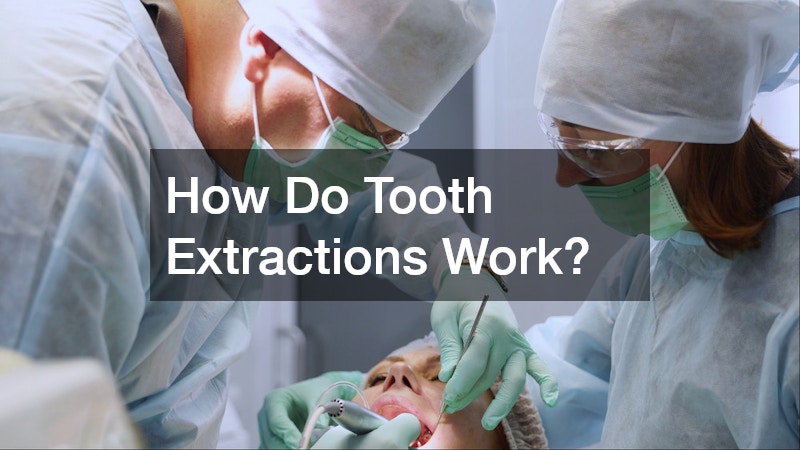
Understanding the process and purpose of tooth extractions helps patients approach the procedure with confidence and clarity. Whether it’s due to decay, overcrowding, or trauma, extractions are sometimes necessary to protect overall dental health. This article explores the reasons behind tooth removal, what happens during the procedure, and how to ensure proper recovery afterward.
What Are the Reasons for Tooth Extraction?
Tooth extraction is typically considered a last resort when other dental treatments cannot restore or preserve the tooth. Dentists recommend it to relieve pain, prevent infection, or prepare for orthodontic procedures.
Severe Tooth Decay or Infection
When tooth decay penetrates deep into the pulp and root, causing infection or abscess, extraction may be the only solution if a root canal cannot save it. Removing the infected tooth prevents the spread of bacteria to nearby teeth or tissues.
Overcrowded Teeth
In some cases, extractions are performed to make space for orthodontic treatments like braces or Invisalign. Removing one or more teeth allows proper alignment and bite correction.
Periodontal Disease
Advanced gum disease can weaken the bone and tissues supporting the teeth. When these structures deteriorate, tooth extractions may be necessary to stop further oral health decline.
Impacted Wisdom Teeth
Wisdom teeth often become impacted — trapped beneath the gum line or growing at an angle — leading to pain, swelling, or infection. Extraction helps alleviate these symptoms and prevent crowding.
Dental Trauma or Injury
Accidents or severe injuries can crack or break teeth beyond repair. In such cases, removing the damaged tooth prevents complications and allows for future restoration options like implants or bridges.
What to Expect During a Tooth Extraction Procedure
Modern dental technology and anesthesia have made tooth extractions safe, efficient, and virtually pain-free. Knowing what to expect before, during, and after the procedure can ease anxiety and ensure a smooth experience.
Preparing for the Extraction
Before the procedure, your dentist reviews medical history, takes X-rays, and discusses anesthesia options. You may receive antibiotics or other pre-procedure medications if an infection is present.
Types of Anesthesia Used
Dentists use local anesthesia to numb the area around the tooth, ensuring comfort during the procedure. For more complex or surgical extractions, sedation or general anesthesia may be used to keep the patient relaxed and pain-free.
The Extraction Process: Simple vs. Surgical
Simple extractions are performed when the tooth is visible and easily accessible. The dentist uses forceps to gently loosen and remove it. Surgical extractions are required for impacted or broken teeth and may involve small incisions in the gum or removal of bone tissue to access the tooth.
Managing Patient Anxiety
Many patients feel nervous about extractions. Dentists often offer sedation options or relaxation techniques to ensure a calm experience. Clear communication about each step helps reduce fear and uncertainty.
Time Duration for Extraction
Most extractions take between 20 to 40 minutes, depending on the tooth’s condition and complexity. Wisdom teeth or surgical extractions may take longer, followed by brief observation before discharge.
How to Care for Yourself After a Tooth Extraction
Proper aftercare is essential to promote healing and prevent complications such as infection or dry socket. Following your dentist’s instructions closely ensures a faster, more comfortable recovery.
Managing Pain and Swelling
Mild pain or swelling is normal after tooth extractions. Over-the-counter pain relievers or prescribed medications can help manage discomfort. Applying a cold compress for 15-minute intervals reduces swelling during the first 24 hours.
Diet Recommendations Post-Extraction
Stick to soft foods like yogurt, soup, mashed potatoes, and smoothies for the first few days. Avoid using straws, as suction can dislodge the blood clot and delay healing. Gradually reintroduce solid foods as comfort improves.
Signs of Potential Complications
If you experience persistent pain, bleeding, fever, or foul odor, contact your dentist immediately. These could indicate infection or dry socket — a condition where the blood clot fails to form properly at the extraction site.
Maintaining Oral Hygiene After Extraction
Continue brushing and flossing other teeth carefully, but avoid the extraction area for the first 24 hours. Rinse gently with warm salt water after meals to keep the mouth clean and promote healing.
Follow-Up Appointments and Recovery Time
Your dentist will schedule a follow-up to check healing progress and remove stitches if needed. Most patients recover within 7 to 10 days, though healing times vary depending on the extraction type and overall health.
Healing Comfortably and Confidently After Tooth Extraction
Tooth extractions are routine yet essential procedures that protect long-term oral health when a tooth cannot be saved. With proper preparation, modern techniques, and attentive aftercare, patients can experience a smooth and safe recovery. By working closely with their dental care team and following post-extraction instructions, individuals can ensure comfort, prevent complications, and pave the way for a healthy, confident smile.

